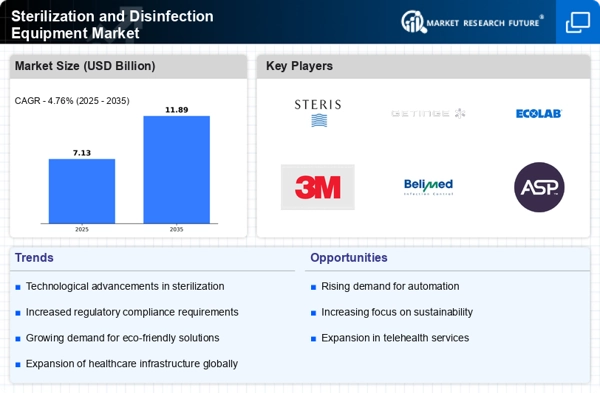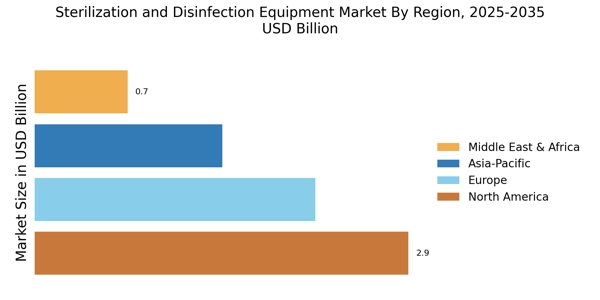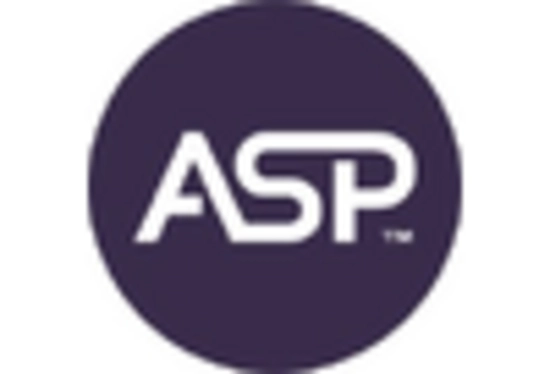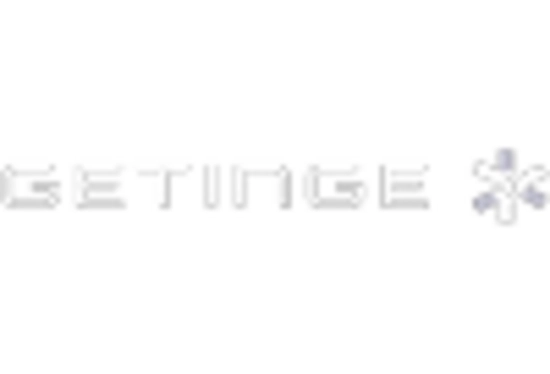Technological Innovations
Technological innovations play a crucial role in shaping the Sterilization and Disinfection Equipment Market. The advent of advanced sterilization technologies, such as low-temperature plasma and vaporized hydrogen peroxide, has revolutionized the sector. These innovations not only enhance the efficacy of disinfection processes but also reduce turnaround times for sterilization cycles. As healthcare facilities strive for operational efficiency, the adoption of these cutting-edge technologies is likely to increase. Market data indicates that the segment of automated sterilization systems is witnessing substantial growth, reflecting a shift towards more efficient and reliable solutions. Thus, technological advancements are expected to drive the Sterilization and Disinfection Equipment Market forward.
Rising Healthcare Expenditure
The Sterilization and Disinfection Equipment Market is experiencing growth due to increasing healthcare expenditure across various regions. As nations allocate more resources to healthcare, the demand for sterilization and disinfection equipment rises. This trend is particularly evident in hospitals and clinics, where maintaining hygiene is paramount. According to recent data, healthcare spending is projected to reach trillions of dollars, thereby driving investments in advanced sterilization technologies. Enhanced funding allows healthcare facilities to upgrade their equipment, ensuring compliance with stringent hygiene standards. Consequently, the Sterilization and Disinfection Equipment Market is likely to expand as healthcare providers seek to improve patient safety and operational efficiency.
Regulatory Standards and Compliance
The Sterilization and Disinfection Equipment Market is heavily influenced by regulatory standards and compliance requirements. Governments and health organizations establish stringent guidelines to ensure the safety and efficacy of sterilization processes. Compliance with these regulations is essential for healthcare facilities, as failure to adhere can result in severe penalties and compromised patient safety. Consequently, the demand for reliable sterilization and disinfection equipment that meets these standards is on the rise. Facilities are increasingly investing in equipment that not only complies with current regulations but is also adaptable to future changes. This trend indicates a sustained growth trajectory for the Sterilization and Disinfection Equipment Market.
Increased Awareness of Infection Control
The Sterilization and Disinfection Equipment Market is significantly influenced by heightened awareness regarding infection control. As the public becomes more informed about the risks associated with healthcare-associated infections, the demand for effective sterilization solutions intensifies. Educational campaigns and guidelines from health organizations emphasize the importance of disinfection in preventing the spread of pathogens. This awareness drives healthcare facilities to invest in state-of-the-art sterilization equipment, thereby propelling market growth. Furthermore, the rise in patient safety initiatives and quality assurance programs reinforces the need for reliable disinfection methods, suggesting a robust future for the Sterilization and Disinfection Equipment Market.
Growth in the Pharmaceutical and Biotechnology Sectors
The Sterilization and Disinfection Equipment Market is benefiting from the expansion of the pharmaceutical and biotechnology sectors. As these industries grow, the need for stringent sterilization processes becomes more critical to ensure product safety and efficacy. Pharmaceutical companies are required to adhere to rigorous quality control measures, which necessitate the use of advanced sterilization equipment. Market analysis suggests that the demand for sterilization solutions in these sectors is likely to increase, driven by the need for compliance with regulatory standards and the pursuit of high-quality products. This growth in the pharmaceutical and biotechnology sectors is expected to positively impact the Sterilization and Disinfection Equipment Market.


















Leave a Comment